Install the app
How to install the app on iOS
Follow along with the video below to see how to install our site as a web app on your home screen.
Note: This feature may not be available in some browsers.
You are using an out of date browser. It may not display this or other websites correctly.
You should upgrade or use an alternative browser.
You should upgrade or use an alternative browser.
2014 YAMAHA
- Thread starter johnm84
- Start date
T
Turbo11T
Well-known member
I think the first pic looks alot better than the second. . . I do not feel as though it is real after looking at the second as the second one looks like photoshop. The Pic overall is not that blurry but some of the lines like where the blue side panel meets the white is blurry as well as where is meets the headlight at the top.
I think cat and yamaha are up to something. I think the first pic could be the final and the second was maybe a test mule.
I think cat and yamaha are up to something. I think the first pic could be the final and the second was maybe a test mule.
here is a zoomed in version of that image.
Does the manufacturer's decal on the tunnel resemble the Yamaha decals of recent years?
How about the Warning/Caution decal on the hood?
Whatever the sled in the background is, it appears to be the same as the one in the foreground.

Does the manufacturer's decal on the tunnel resemble the Yamaha decals of recent years?
How about the Warning/Caution decal on the hood?
Whatever the sled in the background is, it appears to be the same as the one in the foreground.
Last edited:
Ya, the bigger picture makes that MUCH clearer.That is a cat tunnel. Check out the tail light.
It looks like there was a threesome with a Pro, Cat and Apex.
Just thinking out loud.
Lets say this is a PURE ARCTIC CAT sled.
And someone went to all the trouble to re-badge it to make it look like a new Yamaha.
Who would be willing to put in the time and effort to create all the graphics?
And who would have access to a new CAT to rebadge it as a Yamaha??
Lotta work there.....
Lets say this is a PURE ARCTIC CAT sled.
And someone went to all the trouble to re-badge it to make it look like a new Yamaha.
Who would be willing to put in the time and effort to create all the graphics?
And who would have access to a new CAT to rebadge it as a Yamaha??
Lotta work there.....
Yamaha Three-Cylinder Cross-Plane Concept
By Kevin Ash
(click on images for expanded view)
http://www.ashonbikes.com/content/yamaha-three-cylinder-cross-plane-concept
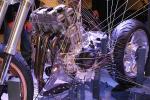
Yamaha has intrigued the bike world with the unveiling of a prototype three-cylinder engine at Cologne, sparking some wild speculation by saying it comes with a cross-plane crankshaft.
The point of a cross-plane crank is covered in detail in this feature here:
Yamaha R1 cross-plane crankshaft feature
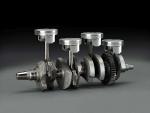
Yamaha R1 cross-plane crankshaftIn brief, the principle is to minimise the rotational fluctuations of the crankshaft caused by the pistons' reciprocating movement. In a conventional four-cylinder engine, at one point all four pistons are stationary, then as the crank rotates through 90 degrees, all four have accelerated to their maximum speed. 90 degrees further on again, all four are stationary once more.
This means a big change in piston inertia, from zero to maximum to zero every half turn of the crankshaft, which is constantly being transferred to and from the crankshaft. For example, when the pistons are slowing down, they're doing so by pushing against the crank, which in turn speeds up. Then as the pistons accelerate from TDC and BDC to maximum speed halfway along the bores, they're gaining inertia from the crankshaft which is pushing them, and the crank slows down.
These cyclic torque fluctuations are large in scale, in a four-cylinder superbike engine they can be of the order of plus and minus 600lb.ft (80kgm, 800Nm). This feature gives an idea of how the numbers are arrived at:
Inertial torque scale calculation feature
This is inherent in the conventional flat plane crankshaft-piston system and is proportional to the rpm, while the torque generated by combustion is overlaid on top of that. The two are referred to as combustion torque and inertial torque.
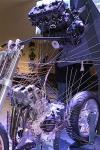
Yamaha prototype cross-plane triple
In a cross-plane four-cylinder the pistons are spaced 90 degrees apart, so there is no point at which they are all stopped or moving at the same speed together. The inertial gains of any one piston are always being cancelled out by the inertial losses of another, resulting in an even rotation speed of the crankshaft, free of inertial torque fluctuations.
Yamaha says this results in a more direct feeling for the rider, in part because whenever he opens the throttle he gets only the combustion torque, without the large inertial torque fluctuations clouding the output, and in part because there is no need for a driveline cushion (such as the springs you see in embedded in many clutch back plates) to protect the gearbox from inertial torque vibration - this also filters out feedback to the rider.
How could this be achieved in a three-cylinder engine? Yamaha has given us a clue, describing the new engine as having a cross-plane crank. Senior executive Kunihiko Miwa also said "...this means the kind of torque character that gives riders the exact torque they want when they need it," confirming the new engine will have zero inertial torque, as it's the same language used for the cross-plane R1. This rules out conventional 120 degree crank throws, which would hardly be innovative anyway as every other triple bar early Laverda Jotas uses this layout. The Jota had 180 degree crank throws, simply because its engine was a twin with an extra cylinder grafted on and Laverda only had the tooling to do it this way.
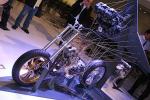
R1 and M1 engines above and behind the new three cylinderIn the Yamaha three-cylinder, cross-plane design there are two possibilities. Either the two outer pistons move up and down together, with the third following at 270 degrees, or the outer two are set at 180 degrees apart, with the centre piston at 90 degrees between them, in effect an R1 crankshaft with the end cylinder removed, an idea that fits in with Yamaha's Cologne display where the link to the R1 and cross-plane M1 MotoGP engine was made.
This is easy enough to balance, but the problem is, the inertial torque is a long way from being zero. In fact the fluctuations are similar to a single-cylinder engine of the same capacity as one of the Yamaha's three cylinders. The solution though could be with us already in a very different Yamaha, the T-Max.
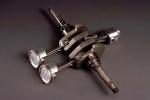
T-Max crank with slave piston at 180 degrees offsetThis is a parallel twin balanced by a slave piston set at 180 degrees to the cylinders. Inertial torque is at its maximum in this design but it doesn't matter, as throttle response is dulled anyway by the auto transmission. But it does show how the Yamaha three-cylinder cross-plane crank could be made to have zero inertial torque. In this, the fourth, slave piston's inertia works with the centre piston's in cancelling out the inertia of the other two. Do note this is inertia we're talking about, not out-of-balance forces, although it can cancel some of those too.
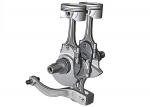
BMW F800 reciprocating balancerThere are alternatives producing the same fundamental result of zero inertial torque in the three-cylinder plus reciprocating balancer layout. One is to use instead of the slave piston a bobweight counterbalance like that in BMW's F800 twin:
BMW Reciprocating Engine Balancer feature
This is bulkier than the slave piston design but it has lower friction levels and offers additional horizontal motion components which can be carefully designed to help counterbalance vibration.
But I'm betting on a final option as it's the most elegant, lightest, lowest cost and results in a stiffer crankshaft. This still involves a fourth conrod, but rather than have its own crankpin it runs on the same crankpin as the centre cylinder (like a V-twin). This means the slave piston (or counterbalance bobweight) moves in the same rather than the opposite direction to the centre cylinder piston. At the same time, the outer two pistons would also move up and down together, firing at 360 degree intervals. Inertial torque levels are still zero (or strictly speaking, very close to zero, as in the R1), as the two pairs of pistons are moving 90 degrees out of phase with each other, but there are now large out-of-balance forces. These though are easy to counter, using a contra-rotating balance shaft in front of or behind the crank. The advantage of this design is it leaves room for a crankshaft bearing between each cylinder, a much stiffer design better suited to high revs and power outputs.
As with the R1, the exhaust note would be unique and appealingly gruff and offbeat, with possible firing intervals at 360-90-270 degrees. By comparison, the R1 has 270-180-90-180 degree intervals, showing that Yamaha is not shy of using overlapping combustion cycles just 90 degrees apart.
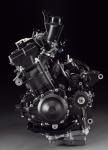
R1 engine - sump is more compact than smaller triple'sThis all fits with the aim of cancelling inertial torque and also draws on existing Yamaha technology while moving it forward in an innovative way, exactly as the company wishes to do. There are some visual clues in the engine itself which appear to confirm these possibilities. One is the deep and bulky sump design in an otherwise very compact engine, which offers plenty of space for either a slave piston or a counter-balance bobweight. Compare this with the R1 sump, which you might expect to be larger yet it's more compact.
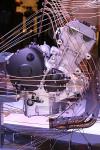
New triple has large balance shaft housing in front of crankSecondly, there is very clearly a housing for a rotating balance shaft in front of the crankshaft. This is also sometimes used on conventional triples so it's not proof in itself, but the final 360 degree cross-plane design must have this, so without it the idea would be scuppered. It's bulky too, as you need to counter the primary out-of-balance forces in this design. The last clue isn't completely clear but it does look as if the spacing between cylinders one and two (numbered from left to right) is slightly greater than between two and three, which would be the case if the centre crankpin was wider and shared by two conrods.

Here's one they prepared earlier...This is all entirely speculation based on Yamaha's existing technology and the handful of clues from Miwa, along with external views of the engine itself. But it does fit, where a great deal of the commentary elsewhere is plainly wrong. For example, the 120 degree layout which many are suggesting does not constitute a cross-plane crankshaft. Cross-plane means lines drawn through the crankpin and crankshaft centres must form a cross when viewed from the end of the crank (which usually is inferred to mean with 90 degree angles), as is the case here. A 120 degree design forms three lines at 120 degrees to each other, which might resonate with Yamaha's triple tuning fork logo, but it's not cross-plane.
It looks like we'll find out for certain in the first half of 2013.
By Kevin Ash
(click on images for expanded view)
http://www.ashonbikes.com/content/yamaha-three-cylinder-cross-plane-concept
Yamaha has intrigued the bike world with the unveiling of a prototype three-cylinder engine at Cologne, sparking some wild speculation by saying it comes with a cross-plane crankshaft.
The point of a cross-plane crank is covered in detail in this feature here:
Yamaha R1 cross-plane crankshaft feature

Yamaha R1 cross-plane crankshaftIn brief, the principle is to minimise the rotational fluctuations of the crankshaft caused by the pistons' reciprocating movement. In a conventional four-cylinder engine, at one point all four pistons are stationary, then as the crank rotates through 90 degrees, all four have accelerated to their maximum speed. 90 degrees further on again, all four are stationary once more.
This means a big change in piston inertia, from zero to maximum to zero every half turn of the crankshaft, which is constantly being transferred to and from the crankshaft. For example, when the pistons are slowing down, they're doing so by pushing against the crank, which in turn speeds up. Then as the pistons accelerate from TDC and BDC to maximum speed halfway along the bores, they're gaining inertia from the crankshaft which is pushing them, and the crank slows down.
These cyclic torque fluctuations are large in scale, in a four-cylinder superbike engine they can be of the order of plus and minus 600lb.ft (80kgm, 800Nm). This feature gives an idea of how the numbers are arrived at:
Inertial torque scale calculation feature
This is inherent in the conventional flat plane crankshaft-piston system and is proportional to the rpm, while the torque generated by combustion is overlaid on top of that. The two are referred to as combustion torque and inertial torque.
Yamaha prototype cross-plane triple
In a cross-plane four-cylinder the pistons are spaced 90 degrees apart, so there is no point at which they are all stopped or moving at the same speed together. The inertial gains of any one piston are always being cancelled out by the inertial losses of another, resulting in an even rotation speed of the crankshaft, free of inertial torque fluctuations.
Yamaha says this results in a more direct feeling for the rider, in part because whenever he opens the throttle he gets only the combustion torque, without the large inertial torque fluctuations clouding the output, and in part because there is no need for a driveline cushion (such as the springs you see in embedded in many clutch back plates) to protect the gearbox from inertial torque vibration - this also filters out feedback to the rider.
How could this be achieved in a three-cylinder engine? Yamaha has given us a clue, describing the new engine as having a cross-plane crank. Senior executive Kunihiko Miwa also said "...this means the kind of torque character that gives riders the exact torque they want when they need it," confirming the new engine will have zero inertial torque, as it's the same language used for the cross-plane R1. This rules out conventional 120 degree crank throws, which would hardly be innovative anyway as every other triple bar early Laverda Jotas uses this layout. The Jota had 180 degree crank throws, simply because its engine was a twin with an extra cylinder grafted on and Laverda only had the tooling to do it this way.
R1 and M1 engines above and behind the new three cylinderIn the Yamaha three-cylinder, cross-plane design there are two possibilities. Either the two outer pistons move up and down together, with the third following at 270 degrees, or the outer two are set at 180 degrees apart, with the centre piston at 90 degrees between them, in effect an R1 crankshaft with the end cylinder removed, an idea that fits in with Yamaha's Cologne display where the link to the R1 and cross-plane M1 MotoGP engine was made.
This is easy enough to balance, but the problem is, the inertial torque is a long way from being zero. In fact the fluctuations are similar to a single-cylinder engine of the same capacity as one of the Yamaha's three cylinders. The solution though could be with us already in a very different Yamaha, the T-Max.

T-Max crank with slave piston at 180 degrees offsetThis is a parallel twin balanced by a slave piston set at 180 degrees to the cylinders. Inertial torque is at its maximum in this design but it doesn't matter, as throttle response is dulled anyway by the auto transmission. But it does show how the Yamaha three-cylinder cross-plane crank could be made to have zero inertial torque. In this, the fourth, slave piston's inertia works with the centre piston's in cancelling out the inertia of the other two. Do note this is inertia we're talking about, not out-of-balance forces, although it can cancel some of those too.

BMW F800 reciprocating balancerThere are alternatives producing the same fundamental result of zero inertial torque in the three-cylinder plus reciprocating balancer layout. One is to use instead of the slave piston a bobweight counterbalance like that in BMW's F800 twin:
BMW Reciprocating Engine Balancer feature
This is bulkier than the slave piston design but it has lower friction levels and offers additional horizontal motion components which can be carefully designed to help counterbalance vibration.
But I'm betting on a final option as it's the most elegant, lightest, lowest cost and results in a stiffer crankshaft. This still involves a fourth conrod, but rather than have its own crankpin it runs on the same crankpin as the centre cylinder (like a V-twin). This means the slave piston (or counterbalance bobweight) moves in the same rather than the opposite direction to the centre cylinder piston. At the same time, the outer two pistons would also move up and down together, firing at 360 degree intervals. Inertial torque levels are still zero (or strictly speaking, very close to zero, as in the R1), as the two pairs of pistons are moving 90 degrees out of phase with each other, but there are now large out-of-balance forces. These though are easy to counter, using a contra-rotating balance shaft in front of or behind the crank. The advantage of this design is it leaves room for a crankshaft bearing between each cylinder, a much stiffer design better suited to high revs and power outputs.
As with the R1, the exhaust note would be unique and appealingly gruff and offbeat, with possible firing intervals at 360-90-270 degrees. By comparison, the R1 has 270-180-90-180 degree intervals, showing that Yamaha is not shy of using overlapping combustion cycles just 90 degrees apart.

R1 engine - sump is more compact than smaller triple'sThis all fits with the aim of cancelling inertial torque and also draws on existing Yamaha technology while moving it forward in an innovative way, exactly as the company wishes to do. There are some visual clues in the engine itself which appear to confirm these possibilities. One is the deep and bulky sump design in an otherwise very compact engine, which offers plenty of space for either a slave piston or a counter-balance bobweight. Compare this with the R1 sump, which you might expect to be larger yet it's more compact.
New triple has large balance shaft housing in front of crankSecondly, there is very clearly a housing for a rotating balance shaft in front of the crankshaft. This is also sometimes used on conventional triples so it's not proof in itself, but the final 360 degree cross-plane design must have this, so without it the idea would be scuppered. It's bulky too, as you need to counter the primary out-of-balance forces in this design. The last clue isn't completely clear but it does look as if the spacing between cylinders one and two (numbered from left to right) is slightly greater than between two and three, which would be the case if the centre crankpin was wider and shared by two conrods.

Here's one they prepared earlier...This is all entirely speculation based on Yamaha's existing technology and the handful of clues from Miwa, along with external views of the engine itself. But it does fit, where a great deal of the commentary elsewhere is plainly wrong. For example, the 120 degree layout which many are suggesting does not constitute a cross-plane crankshaft. Cross-plane means lines drawn through the crankpin and crankshaft centres must form a cross when viewed from the end of the crank (which usually is inferred to mean with 90 degree angles), as is the case here. A 120 degree design forms three lines at 120 degrees to each other, which might resonate with Yamaha's triple tuning fork logo, but it's not cross-plane.
It looks like we'll find out for certain in the first half of 2013.
M
Mcx Nytro
Well-known member
Back in the day I had a Polaris 400L quad. I removed all of the ugly decals and I had some red ski-doo stickers that I put on the grey plastic. I wasn't trying to fool anybody I just didn't like the way it looked. U would not believe how many people came up and asked me about my new skidoo 4wheeler. It was kinda funny.
That sled is definitely a cat chassis. Now if someone went through all the trouble to fool us....... I think thats pretty cool.I wish I would have done it first .lol
When Yami came out with the mtn SRX before I rode it I put on a new tunnel and graphics, I finally gave up and told everyone about 50 people at revy cabin YES this is the 99 srx
 God I miss that sled
God I miss that sled
Remember this saying, Yamaha is very tight lipped.
I don't think anything got leaked.
I don't think anything got leaked.
H
hurricane2
Active member
It looks like the carbides are laying on the running board like it is going to go on to carpet, like maybe a hotel convention room.
Maybe they can rekindle a triple 2-stroke with todays technology and get us a lightweight 170+HP....I miss that triple sound!!
He He.They do look like carbides and I was trying figure out those black items. What the he!! are we gonna do after the big let down. Never seen this much traffic on Yamaha.
This thread has more life to it than anything else around.
Remember this saying, Yamaha is very tight lipped.
I don't think anything got leaked.
I think the guys at the magazine are loving this.
They KNOW all the details and Have all the photos, and are watching all of the speculation.
And the March issue is being printed right now on the presses.
the hood is different for sure on the pic with the rider. But if yamaha is using arctic cats chassis why wouldn't they release a mountain version with it as well? Find out tomorrow.



